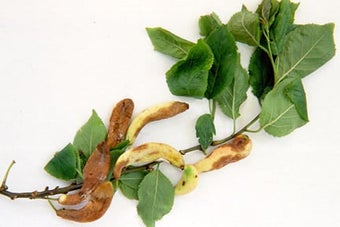
Quick facts
Common name - Witches’ brooms
Scientific name - None
Plants affected - Common on birch, but also frequently seen in cherry, hornbeam, plum and ornamental Prunus species, and several types of conifer.
Main symptoms - Shoot proliferation with short internodes, discoloured and disfigured leaves.
Main causes - Fungal, viral, bacterial or insect activity. Environmental conditions and genetic mutations can also be involved
Timing - Year–round
What are witches' brooms?
In witches’ brooms, of a shoot is interrupted. (that make the twigs and side-shoots) proliferate, causing multiple stems to form in a tangled and disorganised manner.
Many years of growth is required to create big brooms.
Symptoms
You may see the following symptoms in a plant affected by witches' brooms:
- Dense tangled twigs and side-shoots, producing a mass of disorganised growth
- Affected leaves may become dwarfed, discoloured or disfigured
- The needles on conifer witches' brooms appear abnormally short
- Large brooms can be mistaken for birds' nests or squirrels' dreys, particularly when trees are leafless in winter
- Growth of mistletoe (on trees such as apples and poplars) can also look similar when the tree is in active growth and has leaves

Control
Provide plants with optimal growing conditions to keep them healthy and vigorous. On ornamental species where brooms are aesthetically unacceptable, they could be pruned out, otherwise they can be left in situ. Some slight crop loss may occur in brooms on fruit trees as the brooms do not bear fruit.
Biology
The mode of development of witches' brooms is not completely understood in all cases, but a common cause is infection by the fungus Taphrina, with different species causing brooms on birch, hornbeam, plum, cherry and ornamental Prunus species. The fungus is present as mycelium within the brooms and produces spores on the abnormal leaves, but the initial mode of infection is unknown.
On conifers the causes in most cases are unknown apart from the rust brooms on firs (Abies species). Here, infection by the fungal rust pathogen Melampsorella caryophyllacearum causes cankers and witches’ brooms. Spores are produced on the deformed stems and can infect the alternate hosts of the rust, chickweeds and stitchworts (Cerastium and Stellaria spp.).
On herbaceous and witches' brooms can sometimes be caused by the bacterial pathogen Rhodococcus fascians, which causes a disease called leafy gall.
Environmental factors such as frost, drought or damage by animals repeatedly browsing the shoot tips are also thought to cause some cases of witches' brooms, and some brooms are the result of mutations.
Witches’ brooms tend to be more visible in the winter in tree canopies as trees and shrubs lose their leaves. The broom growths may last for many years and in some cases can dominate the crown of the tree.
Several cultivars of plants (e.g. some of the dwarf conifers, such as 'Little Gem' and 'Bird’s Nest' Norway spruce) have arisen as a result of witches’ brooms caused by stable genetic mutations, allowing them to be propagated.
With willow witches’ broom there is some uncertainty as to whether the symptoms are due to the mite Stenacris triradiatus or a virus. In this case catkins or are converted into a dense tuft of short shoots bearing many scale-like leaves. It is found especially on Salix fragilis. S. alba, S. amygdalena. Virus particles have been found in the galled tissues and it is possible that this growth may be virus–induced, rather than being caused by the gall mite.






